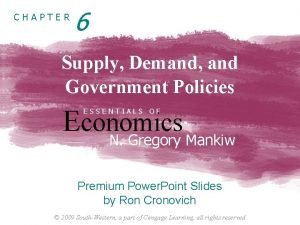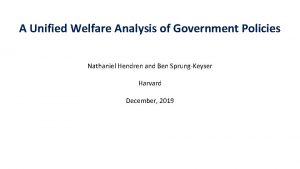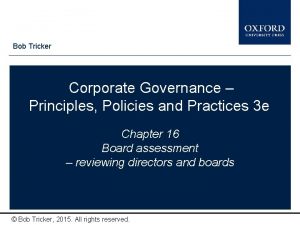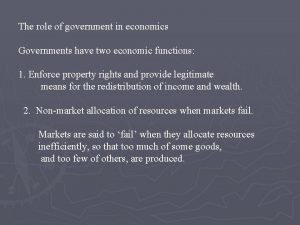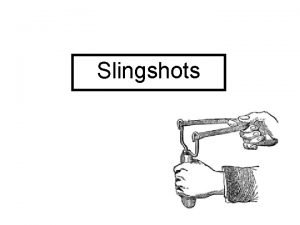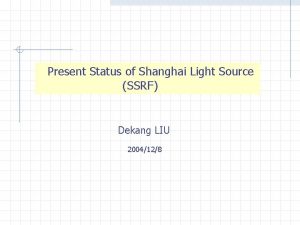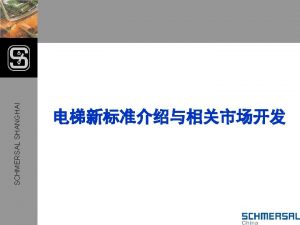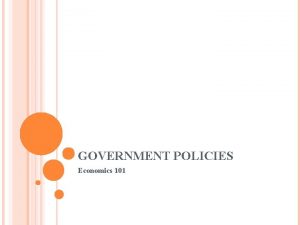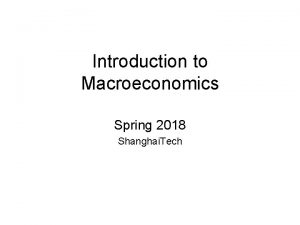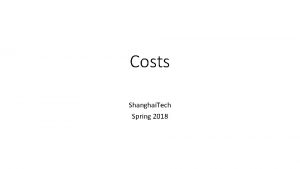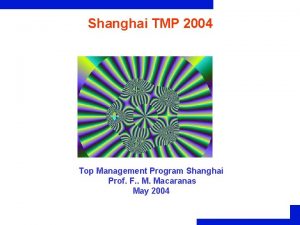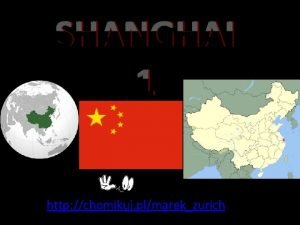Government Policies Principles of Economics Shanghai Tech Spring























- Slides: 23

Government Policies Principles of Economics Shanghai. Tech Spring 2018

Controls on Prices: Price Ceiling • Price ceiling or MAXIMUM PRICE. • Examples rent control, gasoline prices, medicines. • Gas price control after Hurricane Sandy.

Effects of Price Ceiling • Binding price ceiling • Non binding price ceiling

A non-binding price ceiling has no effect on the market outcome. The quantity demanded equals to the quantity supplied P D S 6 5 0 E 40 Q

A binding price ceiling causes a shortage The quantity demanded is larger than the quantity supplied P D S E 7 6 0 A 20 B 40 60 Q

A Case Study of Uber’s Surge Pricing • Uber operates in a market with large fluctuations in demand a variable supply of driver partners. • When there are relatively more riders than driver partners, Uber employs a “surge pricing” algorithm to equilibrate supply and demand. • The surge algorithm works by allocating a higher hourly income to driver partners in order to convince them to work where and when demand is high.

An Example of Price Control in Uber From Hall et al. “The Effects of Uber’s Surge Pricing: A Case Study”



Controls on Prices: Price Floor • Price floor: a legal minimum on the price at which a good can be sold

A non-binding price floor has no effect on the market outcome. The quantity demanded equals to the quantity supplied P D S E 6 4 0 40 Q

A binding price floor causes a surplus (excess supply) The quantity demanded is smaller than the quantity supplied P D 4 S A E 2 0 B 15 40 65 Q

A Minimum Wage Example Wage ($/hr) Labor Supply (by people) Unemployment Min Wage Price floor We Labor Demand (by firms) 40 Quantity of labor This policy would cause a surplus in the labor market – unemployment – because the price floor is binding. The effect is less pronounced when the labor supply is less elastic because fewer workers are drawn into the market by the higher wage.

Evaluating Price Controls • Recall one of the Ten Principles: Markets are usually a good way to organize economic activity. • Price controls often intended to help the poor, but often hurt more than help. • Price ceilings and price floors introduce distortions in the market and cause inefficiencies (waste of resources).

Taxes • Taxes are another type of government intervention in markets. • Two questions to consider: • What is the effect of a sales tax on equilibrium prices and quantities? • Who actually bear the burden of the tax?

A Tax on Buyers • The price buyers pay is now $1. 50 higher than the market price P. Effects of a $1. 50 per unit tax on buyers P S 1 • P would have to fall by $1. 50 to make buyers willing to buy same Q as $10. 00 before. Hence, a tax on buyers shifts the D curve down by the amount of the tax. Tax $8. 50 D 1 D 2 500 Q

A Tax on Buyers New eq’m: Effects of a $1. 50 per unit tax on buyers Q = 450 P Sellers receive PS = $9. 50 Buyers pay PB = $11. 00 Difference between them = $1. 50 = tax PB = $11. 00 Tax S 1 $10. 00 PS = $9. 50 D 1 D 2 450 500 Q

The incidence of a tax: how the burden of a tax is shared among market participants In our example, P buyers pay $1. 00 more, P = $11. 00 B sellers get $0. 50 less. Tax S 1 $10. 00 PS = $9. 50 D 1 D 2 450 500 Q

A Tax on Sellers Effects of a $1. 50 per unit tax on sellers The tax effectively raises sellers’ costs by $1. 50 per unit. Sellers will supply the same quantity only if P rises by $1. 50, to compensate for this cost increase. $11. 50 P S 2 Tax S 1 $10. 00 D 1 Hence, a tax on sellers shifts the S curve up by the amount of the tax. 500 Q

A Tax on Sellers Effects of a $1. 50 per unit tax on sellers New eq’m: Q = 450 Buyers pay PB = $11. 00 Sellers receive PS = $9. 50 Difference between them = $1. 50 = tax P PB = $11. 00 S 2 Tax S 1 $10. 00 PS = $9. 50 D 1 450 500 Q

The Outcome Is the Same in Both Cases! The effects on P and Q, and the tax incidence are the same whether the tax is imposed on buyers or sellers! What matters is this: A tax drives a wedge between the price buyers pay and the price sellers receive. P PB = $11. 00 Tax S 1 $10. 00 PS = $9. 50 D 1 450 500 Q

Elasticity and Tax Incidence CASE 1: Supply is more elastic than demand It’s easier for sellers than buyers to leave the market. So buyers bear most of the burden of the tax. P Buyers’ share of tax burden PB Tax Price if no tax Sellers’ share of tax burden S PS D Q

Elasticity and Tax Incidence CASE 2: Demand is more elastic than supply P Buyers’ share of tax burden S PB Price if no tax Sellers’ share of tax burden It’s easier for buyers than sellers to leave the market. Tax PS Sellers bear most of the burden of the tax. D Q
 Chapter 6 supply demand and government policies
Chapter 6 supply demand and government policies Ben sprung keyser
Ben sprung keyser No tech assistive technology
No tech assistive technology Four seasons korean movie
Four seasons korean movie How seasons work
How seasons work Security program and policies principles and practices
Security program and policies principles and practices Accounting principles and concepts
Accounting principles and concepts Security program and policies principles and practices
Security program and policies principles and practices Security program and policies principles and practices
Security program and policies principles and practices Security program and policies principles and practices
Security program and policies principles and practices Security program and policies principles and practices
Security program and policies principles and practices Bob tricker corporate governance
Bob tricker corporate governance Maastricht university school of business and economics
Maastricht university school of business and economics Non mathematical economics
Non mathematical economics Economic role of government
Economic role of government State and federal constitutions
State and federal constitutions Openstack summit shanghai
Openstack summit shanghai John jakob raskob
John jakob raskob Zip de shanghai
Zip de shanghai Penulis puisi winka dan sihka
Penulis puisi winka dan sihka Shanghai catapult
Shanghai catapult Huopin
Huopin Ssrf
Ssrf What is modern era in the philippines
What is modern era in the philippines
